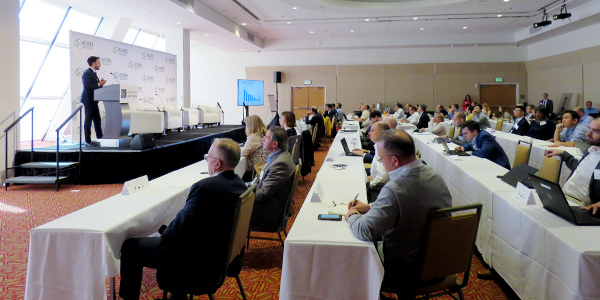By Hudson Sangree
SAN FRANCISCO – Even promoters of renewable energy are starting to worry about reliability as fossil-fuel plants retire and dispatchable renewable resources are slow to take their place.
At the American Council on Renewable Energy’s Renewable Grid Forum on Thursday, speakers talked about the need to replace gas peaker plants with batteries or other resources that can ramp up quickly on demand. Some floated the idea of installing battery storage at natural gas plants to have an instant-on solution to meet peak load. It would be less polluting, at least until the batteries ran out and the gas kicked in, they said.

About 75 people attended the ACORE Renewable Energy Grid Forum in San Francisco Oct. 17. | © RTO Insider
About 75 people attended the event at a Hilton hotel adjacent to San Francisco’s Chinatown and just down the street from the Transamerica Pyramid.
Big utilities have joined the push for renewables, and some utility executives spoke at the meeting.
During one panel on the role of utilities in the transition to renewable energy, Frank Prager, with Xcel Energy, said the company committed in December to carbon-free energy — the first large utility to do so — but is still trying to figure out how to get there by its stated goal of 2050.
Xcel is likely to obtain an 80% reduction in carbon emissions by 2030, but then costs go through the roof, Prager said. The last 20% will be the hardest to achieve, he said.
“We don’t know the pathway to 2050,” he said.
Similar sentiments have been expressed by CAISO and other entities that have vowed to become carbon-free by midcentury. (See CAISO, CPUC Warn of ‘Reliability Emergency’.)
Many have suggested storage coupled with wind or solar as a solution, but Prager said that’s impractical.

A panel on the role of utilities in the transition to renewable energy consisted of (left to right) moderator Gregory Wetstone, ACORE; Julia Hamm, Smart Electric Power Alliance; Peter Toomey, Duke Energy; and Frank Prager, Xcel Energy. | © RTO Insider
Because wind and solar production tends to be seasonal, “you’d have to store terawatt-hours of energy for months at a time,” and that would cost trillions of dollars, he said.
Older technology such as pumped hydro could help. So could advanced nuclear generation, he said. Some developers are working on nuclear units that are much smaller than traditional plants. (See West Wrestles with Resource Adequacy, Grid Reliability.)
Excess energy might be used to create hydrogen that could then be pumped through natural gas pipelines. Fossil fuel with carbon capture and sequestration is another possibility, albeit an expensive one, he said.
Or “Mr. Fusion could come to the fore,” he said, a joking reference to the movie “Back to the Future Part II.”
Federally funded research into new technologies is needed for the nation to totally eliminate carbon emissions from electricity production, Prager and others said.
In the meantime, more utilities are joining the states and cities that have vowed to go all-green. Duke Energy, one of the nation’s largest power producers, pledged in September to go carbon-free by 2050. And PacifiCorp, another energy giant, said last week it planned by 2030 to cut its carbon emissions by 60% below 2005 levels.
“At PacifiCorp, we share a bold vision with our customers for a future where energy is delivered affordably, reliably and without greenhouse gas emissions,” the company said in a statement posted on its website.

Discussing whether renewables and storage can replace gas “peaker” plants were, L to R, Chris Carr, Baker Botts; Kellie Metcalf, EnCap Energy Transition; Thomas Jarvi, Lockheed Martin; and Eeric Cherniss, Vistra Energy. | © RTO Insider
Atlanta-based Southern Co. said in April it planned to go low-to-no carbon by 2050. NextEra Energy, which owns Florida Power and Light, said in June it would reduce carbon emissions by 40% from 2005 levels by 2025. And DTE Energy, a Detroit-based company, said in September it would seek to achieve net-zero-carbon emissions by 2050.
Julia Hamm, CEO of the Smart Electric Power Alliance (SEPA), a group that advocates for carbon-free energy by 2050, said much of the movement toward cleaner energy sources is being driven by cost; renewables, including wind and solar, are among the cheapest forms of energy available now.
But Xcel still deserves credit for its “big, bold commitment,” which prompted other energy companies to jump on the carbon-free bandwagon, she said.
“Since Xcel’s announcement last year,” Hamm said, “the announcements from utilities are coming fast and furious.”
It remains to be seen, however, whether they can meet those commitments.



